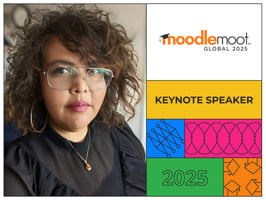MoodleMoot Global is coming soon, and we cannot wait to meet you all in Edinburgh, Scotland! As we...
Who's presenting at MoodleMoot Global 2025? Meet Fred Dixon
A lot of the time, instructors at the gym warn us against “improper form”. That means when you only move your hands and legs in the delusion of a workout, without focusing your attention on your muscles and movement, nothing really happens. According to Fred Dixon, that’s equivalent to switching off your brain while attending an online class – you hear the educator speak, but are you retaining any information?
“Yeah, you can move your body during the day and lift a few things, but nothing’s really going to change. Tomorrow it’ll be the same.”
As the CEO of Blindside Networks and co-founder of BigBlueButton, Fred Dixon is focused on building the world’s most effective virtual classroom. As someone who puts pedagogy-driven design at the heart of everything, for him, BigBlueButton isn’t just a meeting tool – he sees it evolve into an active learning space integrated with Moodle.
What are the challenges of a virtual classroom today?
During what can only be called an edifying conversation, Fred explained,
“If you attend a class but don’t talk, speak up, or participate, is anything really happening in your brain? Some things, maybe – but not much, right? We tend to forget.”
The key challenge in virtual classrooms remains participation. Students attend their classes and more often than not there is a lack of involvement on their end. And this isn’t without a few justifiable reasons.
Vygotsky’z zone of proximal development states that there are things we can all do without assistance, and then there are things for which we need guidance. For example, if we are asked what 2+2 is, we’ll instinctively say 4, because that information is ingrained in us almost like muscle memory.
But there are also skills, knowledge, or anything that we are almost “close” to achieving, but we require additional help to master it. This is where participation plays a key role. It bridges the gap between what the student knows and what they need to know.
As Fred pointed out, this is also where social constructivism comes into play, with interaction and collaboration driving deeper understanding.
If you’re going to learn something significant, you need structure. If you want to learn as efficiently as possible, you also need social constructivism.
The virtue of active learning
Fred mentioned that their main goal at BigBlueButton is to give students the opportunity, the tools to do active learning and also for their instructors to gain visibility of their participation.
“Like we say in the BigBlueButton, there’s no back of the classroom.”
Tools like these don’t directly ask students to participate, such as by turning on their camera or forcing them to do something they might not be okay with. Instead active learning is encouraged through activities such as quizzes, running a quick poll, sending students into breakout rooms, or monitoring participation through activity indicators.
So it’s not the act of getting things into your brain that’s the most effective. It’s actually the act of trying to pull things out of your brain because pulling it out forces your brain to remember.
And because learning styles aren’t as fixed as we think, a virtual class can offer different ways to join in: speaking up, typing in chat, sending a private message to the teacher, or even staying off camera.
Why putting in the work matters
Fred spoke about how connecting with his colleagues and learning about their lives brought a sense of human connection that no technology can replace. He shared his concern that with AI, we are increasingly “cognitively offloading”, relying on tools to do things for us, like using GPS for a familiar route. While it’s human nature to take the easier path, he sees this habit making our brains lazier.
For students, AI can make copying or skipping work feel like the obvious choice, but Fred stressed that the real value lies in doing the work yourself. The aim isn’t just to hand in an assignment, it’s to engage your mind.
Whether in the virtual classroom or in the live classroom, we should feel more frustrated. It is a good feeling, because we know we will come back stronger.
Want to know more?
We are eagerly looking forward to Fred’s talk. In a time of constant dilemma about ethics, morals, and the essence of being human, his presentation will discuss the value of interaction in learning. He will also talk about how you can make your classroom more interactive with Moodle and BigBlueButton.
Learn more about Fred’s talks at the Moot.
Now is the time!


